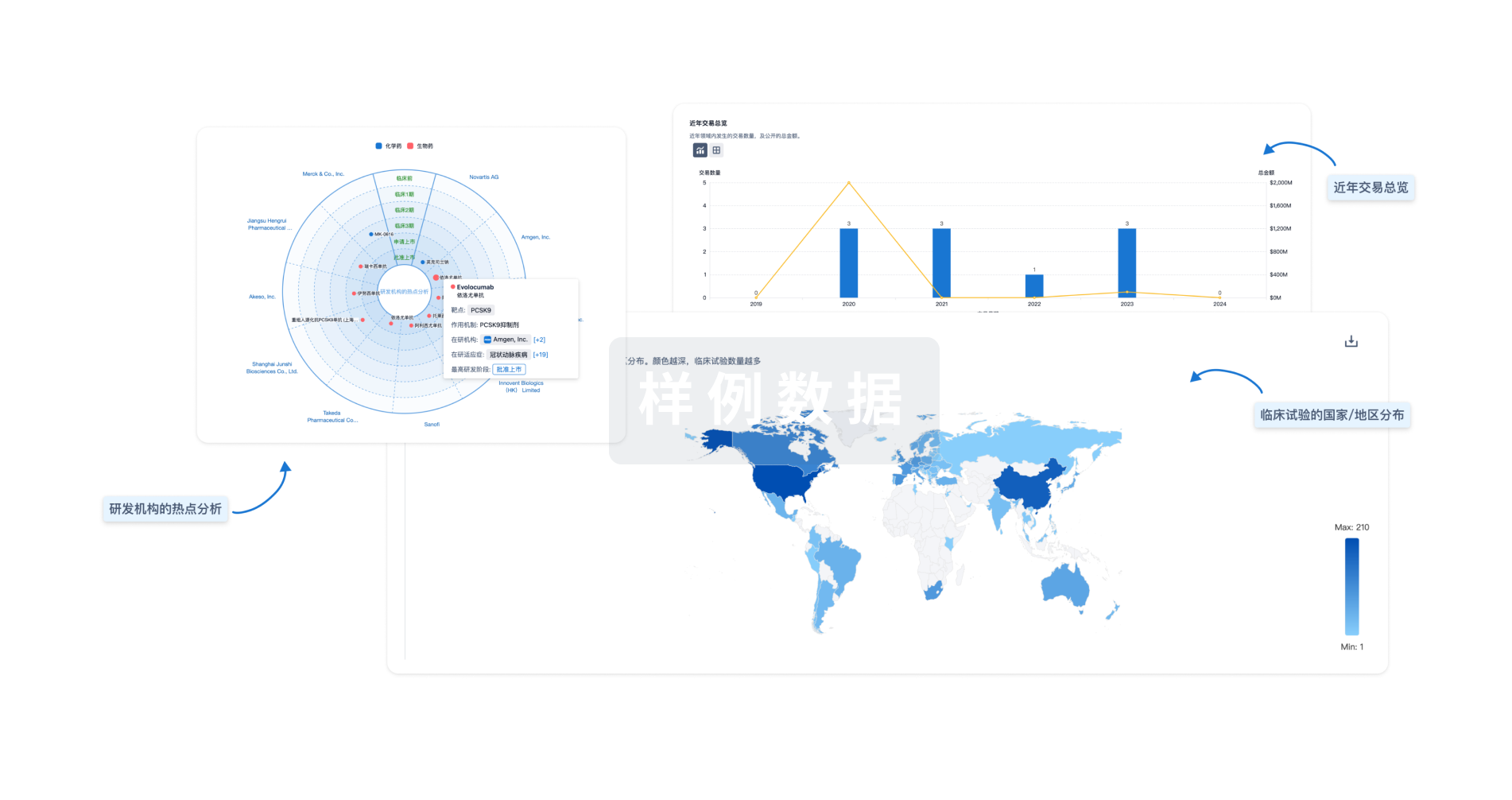预约演示
更新于:2025-05-07
DS
更新于:2025-05-07
基本信息
别名 硫酸皮肤素 |
简介- |
关联
100 项与 DS 相关的临床结果
登录后查看更多信息
100 项与 DS 相关的转化医学
登录后查看更多信息
0 项与 DS 相关的专利(医药)
登录后查看更多信息
364
项与 DS 相关的文献(医药)2025-04-01·Materials Today Bio
A bioactive three-layered skin substitute based on ECM components effectively promotes skin wound healing and regeneration
Article
作者: de Vicente, Juan ; Antich, Cristina ; Chocarro-Wrona, Carlos ; Gálvez-Martín, Patricia ; López de Andrés, Julia ; Jiménez, Gema ; Pleguezuelos-Beltrán, Paula ; López-Ruiz, Elena ; Arias-Santiago, Salvador ; Marchal, Juan Antonio
2025-03-01·Journal of Cell Science
Dachsous is a key player in epithelial wound closure through modulating cell shape changes and tissue mechanics
Article
作者: Pereira, Telmo ; Jacinto, Antonio ; Porfírio-Rodrigues, Patrícia ; Carvalho, Lara
2025-03-01·Biophysical Journal
Fat4 intracellular domain controls internalization of Fat4/Dchs1 planar polarity membrane complexes
Article
作者: Sprinzak, David ; Easa, Yathreb ; Loza, Olga ; Cohen, Roie
1,165
项与 DS 相关的新闻(医药)2025-05-01
·小药说药
如果说参加JPM Healthcare大会如同去米其林餐厅吃饭、参加ASCO大会如同去生鲜超市,那么参加AACR大会就如同逛农贸市场。随着欧美药企BD交易的标的由以前的临床项目为主,到现在出现更多的临床前产品,中国药企的BD战场也从JPM Healthcare大会、ASCO大会转向了AACR大会。刚刚结束的AACR25吸引了超过200款来自中国的创新药亮相,其中ADC产品数量近100款。中国ADC火力全开,其中不乏大量的双抗ADC及双Payload ADC这些赛道领先的技术,甚至还有几款“脑洞大开”的ADC。1、LBL-058LBL-058是由维立志博利用其自己的Linker/Payload技术平台,开发出的靶向DLL3的TCE双抗-药物偶联物(TEC),由靶向CD3/DLL3的双抗与新型拓扑异构酶1抑制剂(TOP1i)载荷组成。LBL-058在不同DLL3表达量的小细胞肺癌(SCLC)肿瘤细胞系中均展现出强效的杀伤。在临床前动物模型中,LBL-058在异种移植瘤模型中诱导持久的肿瘤消退,双抗介导的T细胞激活与ADC的细胞毒产生协同效应,可能克服单一DLL3靶向疗法产生的耐药问题,提示该药物在DLL3表达阳性的SCLC、神经内分泌肿瘤的治疗中具有良好的前景。近日,安进宣布其双抗Tarlatamab(CD3/DLL3)全球首个3期临床试验DeLLphi-304显示:针对铂类化疗后病情进展的患者,疗效显著优于化疗。DeLLphi-304临床试验在计划中期分析中达到主要终点。该研究评估了 Tarlatamab用于治疗经铂类化疗后病情进展的小细胞肺癌(SCLC)患者的疗效。与标准化疗方案(SOC)相比,Tarlatamab在总生存期(OS)方面表现出具有统计学意义和临床意义的显著改善。与此同时,默沙东与第一三共正在开展CD3/DLL3 TCE(MK-6070)与B7H3-ADC(DS-7300)联合治疗SCLC的临床试验。尽管LBL-058在体外及体内实验中取得了良好的药效,但在临床上能否达到甚至超过TCE与ADC联用的效果,目前仍存在较大不确定性。无论是体外实验还是动物体内实验都与患者体内的肿瘤真实环境有较大区别。由于CD3表达于T细胞、胸腺细胞及自然杀伤(NK)细胞,LBL-058是否会造成对这些细胞的杀伤从而引发毒性需要进一步的临床观察。2、YL242YL242是宜联生物基于其TMALIN开发的一款靶向VEGF的非内化ADC,用于实体瘤治疗。4月30日,宜联生物宣布其YL242的临床试验申请已正式获得中国国家药品监督管理局(NMPA)受理。传统ADC的靶点都是通过结合肿瘤细胞表面高表达的抗原产生内吞后释放毒素杀伤肿瘤细胞,而YL242是目前全球第一款进入临床阶段的靶向游离因子的非内吞ADC。但VEGF能否成为一个成功的ADC靶点仍值得商榷。首先,VEGF作用于多种免疫细胞产生不同的功能(图1)。因此,在临床上VEGF单抗(Bevacizumab)治疗实体瘤效果有限并且副作用较高,如Bevacizumab联合化药治疗乳腺癌获批后由于临床获益有限而于2011年被撤回。图1. VEGF作用于不同细胞及产生的功能其次,由于VEGF不具备靶向作用,因此VEGF-ADC能否在肿瘤局部富集并发挥作用存在较大不确定性。如果VEGF-ADC不能在肿瘤局部富集,那么VEGF-ADC起到的作用也许只是VEGF单抗+化药联用的效果(图2)。图2. Bevacizumab+SOC联合治疗NSCLC临床试验结果3、DXA023-G017DXA023是一款由多禧生物开发的,与康方Ivonescimab(PD-1/VEGF双抗)具有相似的2+2结构的双抗。 DXA023与多禧的Linker/Payload G017偶联形成PD-1/VEGF双抗偶联物(DXA023-G017)。尽管PD-1在肿瘤特异性T细胞上高表达,PD-1也在活化的T细胞、NK细胞、B细胞、巨噬细胞、树突状细胞(DC)和单核细胞上表达。与YL242相似,DXA023也不具备靶向作用,因此DXA023-G017在接触到肿瘤细胞前会与血液中的免疫细胞接触并可能产生杀伤作用。Ivonescimab的Fc区域经过工程改造,引入了L234A和L235A两个关键突变位点。这一改造能够阻断FcγRI/IIIa的结合,从而有效抑制Fc介导的多种效应功能,包括抗体依赖的细胞介导的细胞毒性(ADCC)、补体依赖的细胞毒性(CDC)、抗体依赖的细胞吞噬作用(ADCP)以及抗体依赖的细胞因子释放(ADCR)。此外,该改造还显著减少了人外周血单核细胞(HPMMs)炎症细胞因子的释放(图3)。图3. Ivonescimab的Fc改造以提高临床安全性而DXA023-G017的作用机制与Ivonescimab的Fc改造正好相反,因此DXA023-G017可能产生的临床毒性需要谨慎评估。随着ADC赛道不断内卷,行业竞争已进入白热化阶段。由于好靶点数量有限,不少公司希望通过选择不同的靶点组合设计而成双抗ADC、通过不同毒素组合设计而成双Payload ADC、选取非经典ADC靶点设计而成“脑洞型”ADC以期获得领先于其他竞争对手的产品。无论是哪种方式,都需要精巧的分子设计、仔细的体外体内筛选、临床前毒理评估以及提前的临床转化布局才能最终取得成功。公众号内回复“ADC”或扫描下方图片中的二维码免费下载《抗体偶联药物:从基础到临床》的PDF格式电子书!公众号已建立“小药说药专业交流群”微信行业交流群以及读者交流群,扫描下方小编二维码加入,入行业群请主动告知姓名、工作单位和职务。
抗体药物偶联物AACR会议临床1期临床结果ASCO会议
2025-04-30
点击蓝字 关注我们编者按2025年美国癌症研究协会(AACR)年会上,中国原研HER2 抗体偶联药物瑞康曲妥珠单抗(SHR-A1811)携HORIZON-Lung研究最新数据重磅亮相:ORR 74.5%,中位PFS 11.5个月,ILD发生率仅8.5%,刷新全球同类研究记录。瑞康曲妥珠单抗以“高效低毒”的完整数据链,重新定义HER2突变NSCLC治疗标准,标志着中国创新药即将从“跟跑”转向“领航”。我们特邀研究Leading PI陆舜教授,解读数据背后的科学逻辑与临床价值,以飨读者。陆舜 教授● 上海交通大学医学院附属胸科医院终身教授,上海市肺部肿瘤临床医学中心主任● 博士生导师,二级教授 ,国家卫生健康突出贡献中青年专家,上海市领军人才,上海市优秀学术带头人,享受国务院特殊津贴,教育部-上海市 生物医药临床研究与转化协同创新主任● 2024科睿唯安“全球高被引科学家名单”● 中国抗癌协会肺癌专业委员会名誉主委● 中国临床肿瘤学会(CSCO)常务理事 ,希斯科基金会副理事长● DIA中国区顾问委员会前任主席● 上海市医学会肿瘤学会前任主任委员● 中华医学会肿瘤学会常委,肺癌专家委员会主任委员● 上海市医师协会肿瘤专科分会会长,专科规培组长● 国际肺癌研究会官方杂志Journal of Thoracic Oncology,Lung Cancer副主编。 ● 第一负责人主持科技部国家慢病重点专项,国际合作课题;国家新药创新重大专项,863重大课题子课题2项;国家自然基金重点项目和面上项目● 第一负责人获上海市科技进步一等奖。中国抗癌协会科技奖一等奖;中华医学科技奖二等奖,华夏医学科技奖二等奖;上海市医学科技奖一等奖;2021获上海交通大学校长奖;“药明康德生命化学研究奖”,2024获“DIA全球卓越奖”,仁心医者上海市杰出专科医师奖Q1:在美国芝加哥举办AACR大会中,HER2突变NSCLC治疗领域又传喜讯,由您牵头开展的HORIZON-Lung研究更新随访数据,ORR达到74.5%,mPFS长达11.5个月,请您谈谈该结果对HER2突变NSCLC的治疗格局有何重要意义?陆舜教授:非常开心能在AACR大会中与全球的同仁们分享HORIZON-Lung研究的最新成果,瑞康曲妥珠单抗(SHR-A1811)治疗既往经治的HER2突变晚期或转移性NSCLC中位随访时间达到14.2个月,IRC评估的ORR达到了74.5%,较柳叶刀肿瘤学期刊中报道的既往数据73.4%进一步提升,且刷新了全球同类研究的记录[1,2]。这一结果坚实地奠定了瑞康曲妥珠单抗作为HER2突变患者后线治疗的首选地位。亚组分析显示基线脑转移的患者,ORR高达87.5%,为脑转移患者带来了强效缓解的新选择;既往经过抗HER2酪氨酸激酶抑制剂(TKI)治疗的患者同样取得令人欣喜的结果,ORR达到81.8%,提示抗HER2 TKI治疗后的患者仍能从瑞康曲妥珠单抗治疗中获益,使得临床治疗过程中有着更加丰富的选择。中位至缓解时间(TTR)仅为1.4个月,中位的靶病灶直径总和(SoD)退缩率达到了54%,显示出瑞康曲妥珠单抗快速缩瘤起效的特性[1]。图1. HORIZON-Lung研究设计图2. HORIZON-Lung研究更新肿瘤缓解情况图3. HORIZON-Lung研究客观缓解率亚组分析mPFS达到11.5个月,12个月的PFS率达到了48.6%。亚组分析显示,基线脑转移的患者中位PFS也达到了11.3个月,体现出脑转移患者能够从瑞康曲妥珠单抗中取得持久的肿瘤控制。既往经过抗HER2 TKI治疗的患者,中位PFS也达到了9.7个月。图4. HORIZON-Lung研究IRC评估的PFS曲线与研究者评估的PFS曲线图5. HORIZON-Lung研究PFS亚组分析截至本次数据分析时,虽然中位随访时间已经达到14.2个月,但中位OS仍然尚不成熟,12个月的OS率达到了88.2%。图6. HORIZON-Lung研究OS曲线相较于同类进口抗HER2 ADC(DS-8201)在中国人群中开展的DESTINY-Lung05研究,HORIZON-Lung研究中位随访时间更长(14.2个月 vs. 9.8个月),有效率更高(IRC评估的ORR为74.5% vs. 58.3%),疾病控制时间更久,疗效数据更加稳健(IRC评估的中位PFS为11.5个月 vs. 未达到,研究者评估的中位PFS为12.5个月 vs. 10.8个月)[1,16]。优异的疗效数据填补了中国HER2突变晚期NSCLC患者抗HER2治疗领域的空白,我相信未来瑞康曲妥珠单抗会成为临床医生治疗HER2突变NSCLC的利器,为患者带来长久的生存获益。Q2:本次更新中瑞康曲妥珠单抗不良反应导致的停药率仅为2.1%,ILD发生率仅为8.5%,远低于同类药物。您认为其安全性优势源于哪些药物关键设计?陆舜教授:在随访时间延长的情况下,因为患者药物暴露时间增长,通常我们会发现更多的药物不良反应。但在HORIZON-Lung研究中我们发现,中位随访时间从8.7个月延长至14.2个月,瑞康曲妥珠单抗(SHR-A1811)不良反应的发生谱和发生率并没有明显变化和增高,体现出了其卓越和稳定的药物安全性。图7. HORIZON-Lung研究安全性数据更新从药物研发设计角度来看,瑞康曲妥珠单抗能够实现“高效低毒”特性的原因主要有三个方面:首先,毒素方面创新性地使用了更强载荷瑞泽替康,作为新一代拓扑异构酶I抑制剂,其细胞毒性IC50值更低,脂溶性与透膜性相较于DXd更强,潜在的旁观者杀伤效应更强。图8. 瑞康曲妥珠单抗载荷瑞泽替康抗肿瘤活性与理化参数其次,DAR值的设计是第二个亮点。DAR值指的是附着在单个单抗上的有效载荷分子的平均数量,瑞康曲妥珠单抗DAR值为6(DS-8201为8),临床前研究显示,同等剂量下瑞康曲妥珠单抗与DS-8201旁观者效应和抑瘤效应相当。DAR=6的设计,减少了毒素进入人体的总量,更贴合亚裔患者对化疗毒性的耐受阈值。在确保疗效的基础上兼顾了安全性,降低了潜在的不良反应发生率[3,4]。最后,瑞康曲妥珠单抗的毒素在与连接子结合处,创新性地引入了手性环丙基结构,极大地提升了载荷与连接子结合后在血浆中的稳定性,21天血浆中载荷释放率<1%,低于DS-8201的1.2%~3.9%,结构更加稳定,避免了毒素在血浆中不受控释放,带来更加安全的特性[3-5]。图9. 瑞康曲妥珠单抗与DS-8201体外血浆稳定性分析独特的药物结构设计奠定了瑞康曲妥珠单抗“高效低毒”的特性,ORR高达74.5%,mPFS为11.5个月。更为关键的是安全性优势明显,在更长的随访时间下(SHR-A1811随访时间为14.2个月,DS-8201 5.4mg/kg剂量组中位随访时间为15.8个月),瑞康曲妥珠单抗不良反应导致的停药率仅为2.1%,显著低于DESTINY-Lung02研究中的14.9%;间质性肺病(ILD)发生率也仅为8.5%,同样显著低于DESTINY-Lung02研究中的14.9%,仅有1例3级ILD的发生。总之,本次临床研究数据印证了研发思路,瑞康曲妥珠单抗即将为中国HER2突变NSCLC带来了“高效低毒”新选择[1,2,6]。Q3:基于当前数据,瑞康曲妥珠单抗是否可能改写HER2突变NSCLC的后线治疗策略?后续研究探索将如何推进?陆舜教授:答案是显而易见的,HORIZON-Lung研究数据结果已远远超过传统的二线治疗数据ORR不足30%,mPFS低于6个月,为HER2突变NSCLC带来了显著的获益。基于该项研究[7-11],瑞康曲妥珠单抗已经被国家药品监督管理局药品审评中心(NMPA)纳入优先审评通道,即将获批上市,惠及中国HER2突变晚期NSCLC患者[12]。不仅如此,好药应该先用。瑞康曲妥珠单抗拥有快起效,强缓解,长生存的特点,我相信不仅会改写HER2突变NSCLC的后线治疗策略,在一线治疗领域同样能为患者带来长久获益。目前,我们已启动一项多中心Ⅲ期临床试验(NCT06430437),旨在头对头比较瑞康曲妥珠单抗与含铂化疗联合免疫治疗在HER2突变NSCLC一线治疗中的疗效和安全性,期待该项Ⅲ期研究数据在未来的国际大会中公布。此外,HER2变异的另外两种类型HER2扩增与HER2过表达不同于HER2突变,同样是患者预后较差的因素,HER2扩增人群占NSCLC比例约为2.4%~20%[13,15],HER2过表达约占6%~35%[14],这两类患者同样有着非常大的临床需求,所以我们也在开展一项Ⅱ期研究,旨在探索瑞康曲妥珠单抗单药或联合免疫治疗在这部分人群中的潜在价值。Q4:中国原研ADC药物正快速崛起。您如何看待瑞康曲妥珠单抗对全球肺癌治疗生态的影响?陆舜教授:本次的AACR大会中,ADC已经成为最受关注的治疗模式,占据本届大会的核心位置。在大会亮相的众多ADC成果中,中国ADC近乎占据半壁江山,体现出了中国在ADC治疗领域的强大实力。瑞康曲妥珠单抗对于全球肺癌治疗生态的影响主要体现在两个层面:第一,科学层面。瑞康曲妥珠单抗作为恒瑞自主研发的ADC,验证了更强载荷(瑞泽替康DXh)+DAR值优化策略能够带来高效低毒的ADC药物,为中国乃至全球ADC的研发提供了新范式。第二,临床研究层面。瑞康曲妥珠单抗即将基于HORIZON-Lung研究的突破性成果获批上市,为既往经治的晚期或转移性HER2突变NSCLC患者提供创新治疗方案。此外,我们还在进行HER2突变一线治疗与HER2扩增/过表达后线治疗人群探索,希望为更多HER2变异患者带来疗效更加卓越、安全性更加可控、可及性更高的国产药物新选择。当然,如何布局开展国际多中心研究,让好的药物造福全球患者,真正做到中国创新,全球共享,也是当前我们更为关键的课题。我期待瑞康曲妥珠单抗能够以此研究为契机,进一步向全球肺癌治疗领域拓展,也希望国产ADC能从“亮剑”到“称雄”,开创源自中国、造福世界的ADC治疗新时代。扫码下载AACR HORIZON-Lung原文参考文献(上下滑动可查看)[1] Lu S, et al. AACR 2025[2] Li Z, Wang Y, Sun YP, Si W, Lu S. Trastuzumab rezetecan, a HER2-directed antibody–drug conjugate, in patients with advanced HER2-mutant non-small-cell lung cancer (HORIZON-Lung): phase 2 results from a multicentre, single-arm study. The Lancet Oncology 2025.[3] Ting. Z, et al. 2023 AACR LB031[4] Ting. Z, et al. Research Square: doi.org/10.21203/rs.3.rs-3770094/v1[5] Ogitani Y, et al. Clin Cancer Res (2016) 22 (20): 5097–5108.[6] Pasi A. Janne, et al. 2024ASCO Poster 8543[7] Cooper AJ,et al. J Clin Oncol. 2022 Mar 1;40(7):693-697.[8] Mazieres J, et al. Annals of Oncology 27: 281–286, 2016 [9] Shepherd FA, et al. J Clin Oncol18:2095-2103, 2000. [10] Ioannis A Vathiotis et al.Cancers (Basel). 2023 Feb 17;15(4):1286. [11] Chu X, Qiang H, Xie M, et al. Cancer Immunol Immunother. 2022;71(7):1625-1631 [12] www.nmpa.gov.cn[13] Pollock NI, Grandis JR, Cin Cancer Res 2015;21:526-33;[14] Iqbal N, Iqbal N, Mol Biol Int 2014; 2014:852748[15] Shiwang Wen et al. Oncologist. 2019 Nov;24(11):e1070-e1081[16] Ying Cheng, et al. 2024 AACR. CT248声明:本文章代表专家个人观点,仅作为学术交流,不代表平台立场。(来源:《肿瘤瞭望》编辑部)声 明凡署名原创的文章版权属《肿瘤瞭望》所有,欢迎分享、转载。本文仅供医疗卫生专业人士了解最新医药资讯参考使用,不代表本平台观点。该等信息不能以任何方式取代专业的医疗指导,也不应被视为诊疗建议,如果该信息被用于资讯以外的目的,本站及作者不承担相关责任。
AACR会议抗体药物偶联物临床结果
2025-04-30
·药学进展
“点击蓝字 关注我们复宏汉霖多项创新管线临床前研究数据首次发布 PPS 2025年4月28日,复宏汉霖(2696.HK)宣布,公司将在近日召开的2025年美国癌症研究协会(AACR)年会上以壁报形式发布3项自主研发的最新临床前研究成果,包括一款抗PD-L1和抗VEGF双靶点的双特异性抗体HLX37、一项潜在成为同类最佳的KAT6A/B抑制剂候选分子,以及一个同类首创具有特异性杀伤作用的ADC连接子-毒素。该次AACR大会上发布的研究数据详情如下:HLX37(抗PD-L1/VEGF双抗)摘要标题:一款兼具免疫检查点抑制、抗血管生成及抗肿瘤活性的新型抗PD-L1/VEGF双特异性抗体HLX37A novel anti-PD-L1/VEGF bispecific antibody (HLX37) with immune checkpoint inhibition, anti-angiogenic, and antineoplastic activities分会场标题:Overcoming Checkpoint Inhibition and Tumor Suppression展示形式:摘要及壁报 摘要编号:7303展示时间:美国中部时间4月30日(周三)9:00 AM-12:00 PM展示地点:第39区,展板#18靶向PD-L1与VEGF的双特异性抗体通过结合肿瘤细胞表面的PD-L1,增强抗VEGF药物向肿瘤部位的递送,从而在肿瘤微环境(TME)中实现血管正常化与T细胞激活的协同效应,最终提升抗肿瘤活性。HLX37是一款经合理设计的PD-L1/VEGF双特异性抗体。体外研究显示,HLX37对PD-L1和VEGF均具有较高的亲和力,在VEGF存在时可显著促进PD-L1内吞和下调,同时阻断PD-1/PD-L1和VEGF/VEGFR2信号通路,从而促进T细胞激活并抑制肿瘤血管新生。体内研究表明,HLX37在MDA-MB-231(三阴乳腺癌)、NCI-H292(肺癌)等肿瘤模型中呈现剂量依赖的抗肿瘤疗效。与抗VEGF单抗和抗PD-L1单抗的联合用药组相比,HLX37显示出更高的肿瘤富集效应,该效应可能由PD-L1和VEGF共同介导。在食蟹猴毒性实验中,HLX37在100 mg/kg的给药剂量,单周静脉输注3次的频率下表现出良好的耐受性。鉴于HLX37具有优异的临床前抗肿瘤活性且安全性可控,且能增强肿瘤富集效应,其在多类肿瘤中具有广泛的应用潜力。HLX97(KAT6A/B抑制剂)摘要标题:一款具有显著抗肿瘤活性及低血液毒性的新型KAT6A/B抑制剂的发现Identification of novel KAT6A/B inhibitors with enhanced antitumor activity and reduced hematologic toxicity分会场标题:Lead Identification and Optimization展示形式:摘要及壁报 摘要编号:6976展示时间:美国中部时间4月30日(周三)9:00 AM-12:00 PM展示地点:第25区,展板#5HLX97是潜在的同类最佳的KAT6A/B抑制剂。KAT6A/B是乳腺癌治疗中极具潜力的靶点。一项针对KAT6A/B抑制剂PF-07248144的I期临床研究显示出积极的疗效,但其靶点相关的血液学毒性(尤其是中性粒细胞减少症)可能限制药物剂量的递增。复宏汉霖致力于开发一款具有“快速起效/快速清除”药代动力学特性的高选择性KAT6A/B抑制剂,旨在最大化药物抗肿瘤活性的同时减轻产品的血液毒性。与参比化合物PF-07248144相比,HLX97展现出更强的KAT6A/B抑制活性和对KAT5/7/8更高的选择性,并在ZR-75-1细胞模型中产生更强的细胞毒效应。同时,HLX97显示出良好的ADME特性,包括高口服生物利用度和优异的药代动力学特征。在ZR-75-1异种移植模型中,经过五周治疗,HLX97显示出剂量依赖的体内抗肿瘤疗效,且动物体重下降极小。HLX97更强的KAT6A/B抑制能力和"相对更快的"体内清除速率可能共同促成了其更宽的治疗窗口。在大鼠单次给药急性毒性试验中,HLX97在100 mg/kg剂量下耐受良好。基于HLX97优异的疗效和安全性特征,复宏汉霖计划于2025年底递交该产品的新药临床试验(IND)申请。新型ADC连接子-荷载毒素摘要标题:一款通过持续激活未折叠蛋白反应(UPR)实现独特杀伤机制的新型抗体偶联药物(ADC)连接子-载荷组合的发现Discovery of a novel antibody-drug conjugate linker-payload with a distinct killing mechanism via prolonged unfolded protein response activation分会场标题:Drug Design, Synthesis, and Disposition展示形式:摘要及壁报 摘要编号:5730展示时间:美国中部时间4月29日(周二)2:00 PM-5:00 PM展示地点:第25区,展板#1一类具有3-(4-羟苯基吲哚啉-2骨架结构的化合物,通过持续激活未折叠蛋白反应(UPR),对高表达TRPM4或雌激素受体阳性的癌细胞展现出强效抗肿瘤活性,该杀伤机制与现有毒素不同。此类化合物对多数健康组织毒性较低,主要副作用为胃肠道毒性,代表性化合物包括ErSO和泻药醋酸氧苯乙酯。为克服ADC耐药性,或与现有ADC产生协同,复宏汉霖构建了一类全球首创的ADC 连接子-荷载毒素—以此类化合物优化后得到的HLX91-048作为毒素载荷,通过可裂解的GGFG连接子与抗HER2抗体偶联,形成药物抗体比(DAR)为4或8的偶联物。研究表明,与ErSO相比,HLX91-048的细胞毒性提升了10倍以上,在多类肿瘤细胞中显示出亚纳摩尔至纳摩尔级别的IC50值。相较于DS-8201类似物,基于HLX91-048的抗体药物偶联物(ADC)在多种细胞系中表现出更强的细胞毒性、更显著的旁观者杀伤效应,并且在人及猴血浆中稳定性更高。研究证实,基于HLX91-048的ADC可显著激活未折叠蛋白反应(UPR),与预期一致。基于HLX91-048的DAR4(药物抗体比4)的HER2 ADC在BT474和NCI-N87模型中均显示出剂量依赖性的抗肿瘤效果,在较高剂量(10-12 mg/kg)下实现显著的肿瘤消退。值得注意的是,基于HLX91-048的ADC在部分对DS-8201类似物无应答的耐药患者来源的类器官(PDO)模型中仍保持敏感性。在大鼠临床前毒理学评估中,DS-8201类似物和基于HLX91-048的ADC在60 mg/kg剂量下(每周一次,持续三周)均表现出良好的耐受性。基于HLX91-048的连接子-载荷组合具有高度差异化的作用机制,并在临床前评估中展现出卓越的疗效与安全性。其针对非人灵长类动物的初步毒理学研究已纳入开发计划。文章来源:复宏汉霖美编排版:朱玲欣文章审核:隋艾蓉 朱玲欣 罗琪【免责声明】以上内容来源于互联网,不代表本平台立场或观点;如有侵犯作者著作权,请及时与我们联系(Tel:025-83271227,或直接在微信平台留言),我们将及时更正或删除。《药学进展》杂志由教育部主管、中国药科大学和中国药学会共同主办,中国科技核心期刊(中国科技论文统计源期刊)。刊物以反映药学科研领域的新方法、新成果、新进展、新趋势为宗旨,以综述、评述、行业发展报告为特色,以药学学科进展、技术进展、新药研发各环节技术信息为重点,是一本专注于医药科技前沿与产业动态的专业媒体。《药学进展》注重内容策划、加强组稿约稿、深度挖掘、分析药学信息资源、在药学学科进展、科研思路方法、靶点机制探讨、新药研发报告、临床用药分析、国际医药前沿等方面初具特色;特别是医药信息内容以科学前沿与国家战略需求相合,更加突出前瞻性、权威性、时效性、新颖性、系统性、实战性。根据最新统计数据,刊物篇均下载率连续三年蝉联我国医药期刊榜首,复合影响因子1.216,具有较高的影响力。《药学进展》编委会由国家重大专项化学药总师陈凯先院士担任主编,编委由新药研发技术链政府监管部门、高校科研院所、制药企业、临床医院、CRO、金融资本及知识产权相关机构近两百位极具影响力的专家组成。联系《药学进展》↓↓↓编辑部官网:pps.cpu.edu.cn;邮箱:yxjz@163.com;电话:025-83271227。欢迎投稿、订阅!往期推荐聚焦“兴药为民·2023生物医药创新融合发展大会”“兴药为民·2023生物医药创新融合发展大会”盛大启幕!院士专家齐聚杭城,绘就生物医药前沿赛道新蓝图“兴药强刊”青年学者论坛暨《药学进展》第二届青年编委会议成功召开“兴药为民·2023生物医药创新融合发展大会”路演专场圆满收官!校企合作新旅程已启航我知道你在看哟
AACR会议抗体药物偶联物临床1期申请上市
分析
对领域进行一次全面的分析。
登录
或

生物医药百科问答
全新生物医药AI Agent 覆盖科研全链路,让突破性发现快人一步
立即开始免费试用!
智慧芽新药情报库是智慧芽专为生命科学人士构建的基于AI的创新药情报平台,助您全方位提升您的研发与决策效率。
立即开始数据试用!
智慧芽新药库数据也通过智慧芽数据服务平台,以API或者数据包形式对外开放,助您更加充分利用智慧芽新药情报信息。
生物序列数据库
生物药研发创新
免费使用
化学结构数据库
小分子化药研发创新
免费使用